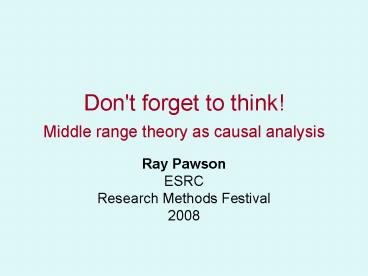Don't forget to think Middle range theory as causal analysis - PowerPoint PPT Presentation
1 / 13
Title:
Don't forget to think Middle range theory as causal analysis
Description:
... harnessing research designs that enhance the precision and refine the scope of ... smuggled in ad hoc and turning on concepts that cannot be expressed as variables ... – PowerPoint PPT presentation
Number of Views:200
Avg rating:3.0/5.0
Title: Don't forget to think Middle range theory as causal analysis
1
Don't forget to think! Middle range theory as
causal analysis
- Ray Pawson
- ESRC
- Research Methods Festival
- 2008
2
The basic thesis
? Causal inferences are made on the basis of and
protected by sound research technique. Good
design and analysis, such as found in RCTs and
multivariate analysis are the foundation stones
of our ability to begin to make causal claims.
? Our ability to detect causal powers lies in the
process of theory testing and refinement. It is
only by harnessing research designs that enhance
the precision and refine the scope of theories
that social science can begin to make valid,
reliable and useful causal inferences.
3
Successionist causal logic (variable based)
O1 X O2 O3 O4
W
X Y
X Y
U
V
Y
U
Z
V
X
4
Generative causal logic (mechanism based)
Context (C)
Mechanism (M)
Outcome Pattern (O)
5
Problems with variable analysis an early
sighting
I usually assign students in a theory class the
following task Choose any relation between two
or more variables which you are interested in
invent at least three theories, not known to be
false, which might explain these relations
choosing appropriate indicators, derive at least
three empirical consequences from each theory,
such that the factual consequences distinguish
among the theories. This I take to be the model
of social theorizing as a practical scientific
activity. A student who has difficulty thinking
of at least three sensible explanations for any
correlation that he is interested in should
probably choose another profession. Stinchcombe
(1968 13)
6
Correlations always yield to multiple explanations
N potential explanations, smuggled in ad hoc and
turning on concepts that cannot be expressed as
variables
X
Y
7
Partial / Multiple Correlations always yield to
multiple explanations
Each path has n potential explanations, usually
smuggled in ad hoc.
The estimates will change with the inclusion of
further variable, differently measured on
different programmes
school achievement
.26
.25
.08
grades
quality of parental relationship
.25
mentoring
self worth
.22
-18
.22
- .09
skipping school
.26
value of school
- .11
-.26
8
Generative explanation in practice
How Merton turned Stouffers Causal Arrow into an
Generative Mechanism
Giant survey of draftees into the US army WW II.
Several pronounced causal links including
(Marital Status Attitude
Draft) 41 of married inductees claim thy should
not have been drafted 10 for single men. On
which basis Stouffer et al declare Comparing
himself with his unmarried associates in the
Army, he could feel that induction demanded
greater sacrifices from him than from them and
comparing himself with his married civilian
friends, he could feel that he had been called on
for sacrifices which they were escaping
altogether.
9
Theories that might usefully be tested to
strengthen the causal inference
- If relative deprivation really is the cause we
need to investigate - Experience that they feel torn (find it hard
to partake in family life whilst soldiering). - Norms they know how it works (norms whereby
recruitment boards are usually softer on the
married). - Knowledgeability they know the score
(comparative rate of induction between singles
and married). - Proximity resentment increases with immediacy
(being surrounded by single in barracks and
drills) - N.B. Testing each conjecture would call on
different strategy (mixed method) BUT N.N.B.
theory leads method (mixed method alone is just
description).
10
True causal explanations have memory and pedigree
- An army private bucking for promotion may only
in a narrow and theoretically superficial sense
be regarded as engaging in behaviour different
from that of an immigrant assimilating the values
of a native group, or of a lower-middle-class
individual conforming to his conception of
upper-middle-class patterns of behaviour, or of a
boy in a slum area orienting himself to the
values of a settlement house worker rather than
the values of the street corner gang, or of a
Bennington student abandoning the conservative
beliefs of her parents to adopt the more liberal
ideas of her college associates, or of a
lower-class Catholic departing from the pattern
of his in-group by casting a Republican vote, or
of a eighteenth century French aristocrat
aligning himself with a revolutionary group of
the time The combination of elements may
differ, thus giving rise to overtly distinctive
forms of behaviour, but these may nevertheless be
only different expressions of similar processes
under different conditions. They may all
represent cases of individuals becoming
identified with reference groups to which they
aspire. - (Merton, 1968332)
11
Another benefit of the theory-testing approach -
The precious property of abstraction
Abstraction and formalisation of a generative
middle-range theory
The demi-regs of study one.
The demi-regs of study two.
12
Why the generative account is to be preferred
- Ontologically sound variables/attributes dont
cause anything. - Makes tacit explicit other approaches smuggle
in ad hoc generative explanation. - Deals with constrained choice intervening
variables are not mechanisms, moderators are not
contexts. - Provides explanations rather than makeshift
descriptions - Deals with Liebersons X14 problem closure by
theoretical saturation and adjudication. - Provides the basis for transferable and
cumulative explanation.
13
Memo to ESRC
- Data never speak for themselves
- Data analysis should not be confused with
explanation - Data agglomeration and technical refinement
produce more complex descriptions - Descriptions are ten-for-a-penny
- Dont forget to ask researchers to think!































